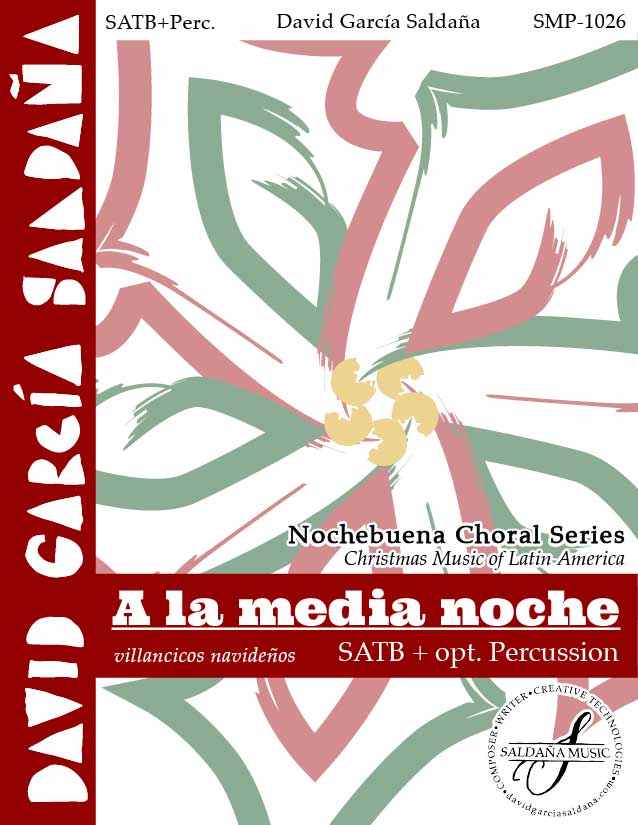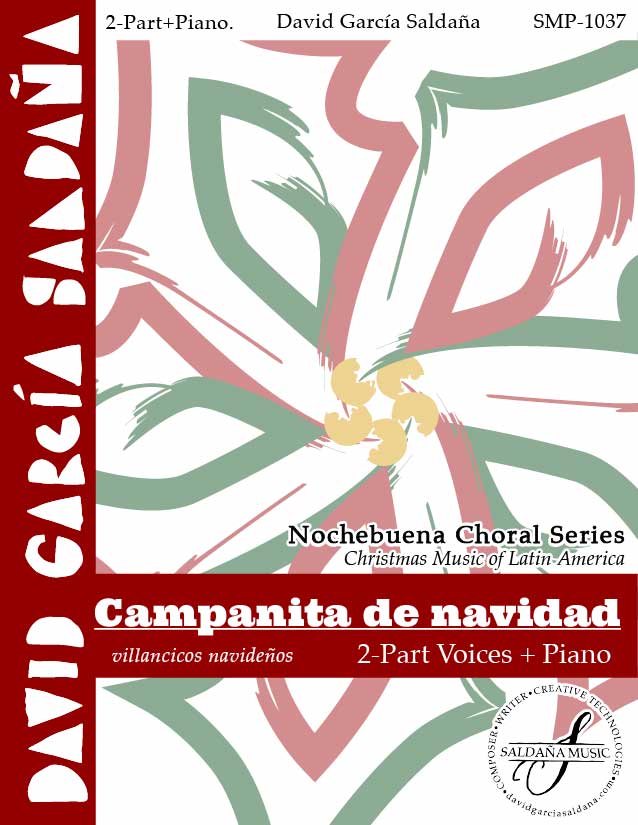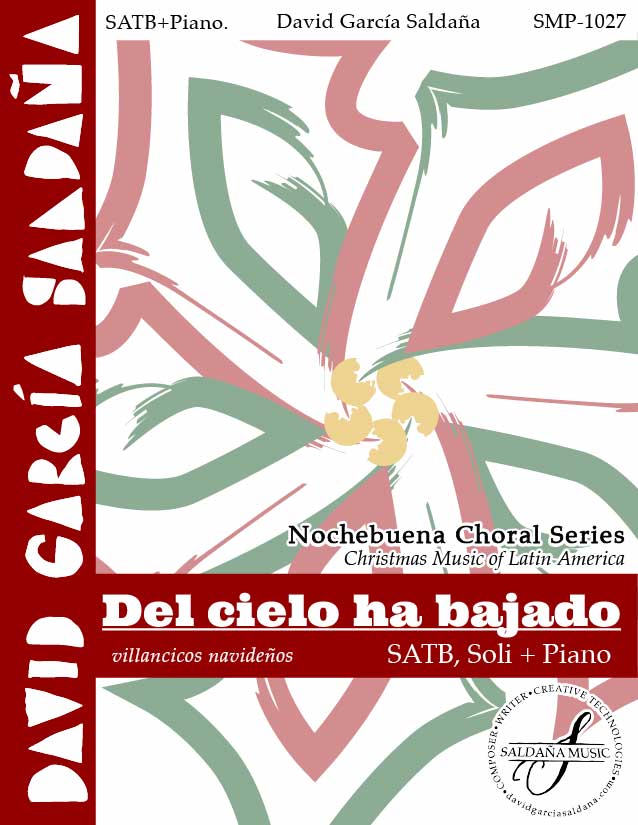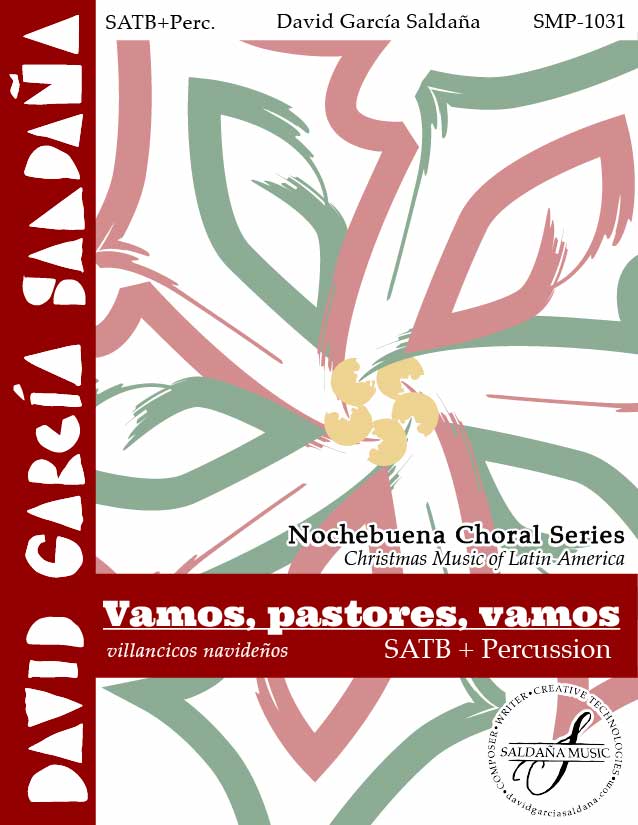Nochebuena Choral Series
Christmas music of Latin America
Notes, translation, pronunciation guides
villancico navideño
noun
• a Hispanic, culturally-Catholic Christmas song.
The Nochebuena Choral Series is a collection of self-published arrangements of villancicos navideños (Christmas carols), curated to capture the various episodes of the nativity narrative. The individual octavos are separate and different than the bilingual cantata composed of the villancicos, “Canciones de Nochebuena.”
Select the villancico below for notes, pronunciation guides, and purchase links!
A la media noche (Puerto Rico)
Notes:
The Puerto Rican aguinaldo originated as a poetic form in the 19th and 20th centuries. “A la media noche” is one setting of well-known verses in hexasyllabic form that centers around tellings of the Catholic nativity narrative. The Journal of American Folklore published collections of these aguinaldos in their 1918 publication, where several versions of these verses can be found. This setting is a plena, a style of music described as a periodico cantado or “sung newspaper” meant as a form of communication across the working class. “A la media noche’s” melody can be found in another very popular secular aguinaldo, “Si me dan pasteles,” usually sung by children as they knock door to door asking for loose change to fund their holiday celebrations. Sung recordings of this tune by Aurora Calderón can be found as far back as the 1939 in the Library of Congress’s digital archives.
Both of these tunes have origins in the aguinaldo jíbaro song style, which the opening lines of each stanza refer to in the melody, and which cuatro puertorriqueño players (a stringed instrument similar to a guitar or ukelele) still learn to play, accompanied by plena rhythm on percussion. This arrangement of the aguinaldo utilizes onomatopoeia in the voices, as well as an Afro-Cuban clave rhythm not present in the original melody..
Pronunciation Guide:
*Universal/Neutral Spanish pronunciation should be attempted in performance.
AUDIO FILE COMING SOON
Lyrics:
A la media noche al rigor del hielo
Nace Jesucristo, redentor del Cielo.
A la media noche el gallo cantaba,
Y en su voz decía ya Cristo ha nacido.
Entre pajas nace del cielo el gran Rey.
A su lado tiene la mula y el buey.
El buey como humilde las pajas le hechaba.
La maldita mula le descobijaba.
Su madre lo mira sin poderle dar
Ni techo ni cuna donde reposar.
Tiernecito Niño mi Jesús, mi Dios,
Eres suave y dulce, eres todo amor.
Translation:
At the stroke of midnight, in the icy night,
Jesus Christ is born, redeemer of Heaven.
At midnight the rooster crowed,
Singing, “Christ has been born!”
In straw, the great King is born from heaven.
At his side he has the mule and the ox.
The humble ox chewed the straw bed.
The naughty mule uncovered him.
His mother looks at him without being able to give
Neither roof nor cradle to rest.
Tender Child my Jesus, my God
You are soft and sweet, you are all love.
Campanita de navidad (Honduras)
Notes:
Honduras’ religious demographics differ from much of Latin America, with a majority practicing Catholicism at only 38%. This, in addition to Honduras having an underdeveloped music recording industry in the early 20th century has resulted in a shortage of accessibly documented Honduran Christmas music. Classical soprano Isabel Salgado Castillo (1930-2020) relied on international travel and success to sustain her operatic singing and recording career. “Canciones Navideñas de Ayer y Hoy” (1969) touts a playlist of popular folk and contemporary Honduran villancicos, but without labeling clearly the source of each tune. Castillo sings this lesser known tune “Campanita de navidad” with quartal harmony on piano and her signature bel canto tone, as if an art song.
This new arrangement maintains the directness of the vocal line in 2-part voices, with a toy-box sounding piano accompaniment that rings nostalgic to an American Christmas aesthetic.
Pronunciation Guide:
*Universal/Neutral Spanish pronunciation should be attempted in performance.
AUDIO FILE COMING SOON
Lyrics:
Se oye el eco de alegres campanas
Anunciando el niñito Jesús.
Entre cantos y aromas de ensueño
Ha llegado nuestro redentor.
Campanita de amor. Campanita de paz.
Hoy se escucha armoniosa tu voz celestial,
Campanita de navidad.
Translation:
Hear the echoes of merry bells ringing!
Now’s the birth of our littlest Jesus.
Cheer with heavenly songs and aromas!
Our redeemer has come to this world.
Bell of holiest love! Bell of holiest peace!
Let us demonstrate heavenly kindness on earth
With this holiest Christmas bell.
Canciones de Nochebuena (Cantata)
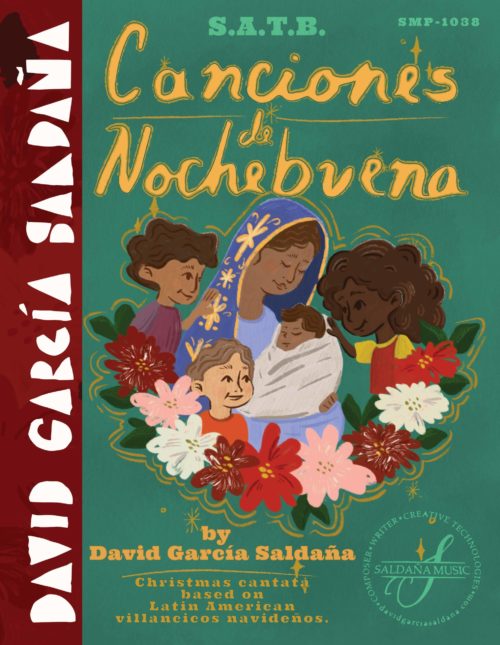 Notes:
Notes:
Canciones de Nochebuena is a choral Christmas cantata that weaves together Hispanic culturally-Catholic songs (villancicos), reflecting the mix of Indigenous, African, and European influences found in post-colonial Latin American mestizo culture. Additionally, this cantata incorporates elements that speak to the current diaspora in the USA, including bilingual English/Spanish lyrics, Latin Jazz percussion, and Classical/Folk fusion. These create a unique blend, a mestizaje, that celebrates Latiné identity’s multiple influences.
The Spanish verses of Canciones de Nochebuena draw from familiar tunes tied to specific regions, each narrating a segment of the nativity story; poetically translated by David García Saldaña.
Pronunciation Guide:
*Universal/Neutral Spanish pronunciation should be attempted in performance.
AUDIO FILE COMING SOON
Del cielo ha bajado (Nicaragua)
Notes:
“Del cielo ha bajado” (LOURDES HYMN) speaks to the power that religious colonization has over Hispanoamérica. The Pew Research Center’s 2014 survey claims 69% Catholic identity of the participants across Latin America. Catholic practices have proliferated across different national Christmastime celebrations, notably in different novenas for this period. Some cultures celebrate leading up to the 25th, while others celebrate after. Nicaragua has an especially unique novena November 28-December 8, referred to as “La Purísima” and culminating in “La Gritería,” national celebrations and adorations of the Virgin Mary.
In the same way Hispanoamérica reclaimed the Spanish colonizer-religion through re-imagining the ceremonies and traditions, this arrangement of “Del cielo ha bajado” intentionally takes a piece of European Catholicism that still holds power over Hispanoamérica and transforms it into something authentically inauthentic through the creative power of musical re-imagination.
Pronunciation Guide:
*Universal/Neutral Spanish pronunciation should be attempted in performance.
AUDIO FILE COMING SOON
Lyrics:
Del cielo ha bajado la Madre de Dios.
Cantemos el Ave a su concepción.
Ave, ave, ave María.
Ave, ave, ave María.
Del verbo divino, de Cristo Jesús,
Santísima Madre, María, eres tú.
El Ángel que envía el Dios eternal,
saluda a María con voz celestial.
Oh Virgen sin mancha, oh Madre de amor,
El ángel te ofrezca mi salutación.
Translation:
The mother of God has come down from heaven.
Let us sing this adoration to her conception.
Hail, Hail, Hail Mary.
Hail, Hail, Hail Mary.
Foretold in the story of Christ’s birth,
The blessed mother, Mary, is you.
The angel, sent by God,
greets Mary with a heavenly voice.
O purest virgin, O mother of love,
The angel offers you my greetings.
El ángel Gabriel (Venezuela)
Notes:
This version of the Annunciation offers a view of Venezuelan Christmas imagery and traditions. Here, the local shephards offer Venezuelan foods and treats to the child, Mary and Joseph camp underneath the Araguaney tree, and local bioluminescent insects provide the holy glow for the scene. The songwriter, Francisco Carreño, contributed to the development of the Servicio de Investigaciones Folklóricas Nacionales and founded the Escuela del Folklore Venezolano (School for Venezuelan Folklore). Carreño’s populist sentiments and research led to political persecution throughout the 1960s, until his death.
“El ángel Gabriel” is an aguinaldo venezolano, typically accompanied by a cuatro (a stringed instrument similar to the guitar) and written in a 5 time signature (3+2), which the opening bars of the choral arrangement has rewritten in 6 and borrows from an Argentinian chacarera hemiolic percussion pattern. The chacarera originally is accompanied by guitar/accordian in 6 time and a bass drum, the bombo legüero, on beats 2 & 3 of the 3 time. This arrangement suggest playing the rhythm on a cajón.
Pronunciation Guide:
*Universal/Neutral Spanish pronunciation should be attempted in performance.
AUDIO FILE COMING SOON
Lyrics:
El ángel Gabriel anunció a María
que al cantar el gallo Jesús nacería.
Y a la media noche, cuando ella dormía,
se cumplió el mandato de la profecía.
Para el nacimento del Dios de Israel,
bajaron cantando los Reyes también.
Y los pastorcillos a Belén se van,
llevando hallaquitas, cachapas y pan*.
San José y la Virgen, la mula y el buey,
reposan debajo de un araguaney**.
Y sobre una mata el Niño se mece
y un haz de cocuyos*** de luz resplandece.
Translation:
The angel Gabriel announced to Mary
that when the rooster crowed Jesus would be born.
And at midnight, when she slept,
the prophecy was fulfilled.
For the birth of the God of Israel,
The three kings came down singing as well.
And the little shepherds came to Bethlehem,
carrying hallaquitas, cachapas and breads*.
Saint Joseph and the Virgin, the mule and the ox,
They rest under an araguaney**.
And on a bush the Child rocks
and a bundle of cocuyos*** of light shines.
*Hallacas are a traditional Venezuelan steamed dish similar to the Mexican tamal. Cachapas are a traditional Venezuelan corn cake. The breads referred to are most likely sweet pastry holiday breads.
**The national tree of Venezuela that grows throughout neighboring countries. It has yellow flowers resembling the Venezuelan flag.
**Cocuyos, also known as glowing click beetles, are tropical bioluminescent insect sometimes confused with a firefly.
El rorro (México)
Notes:
This villancico has a well-documented performance history with mixed choir as a centuries old lullaby to the newborn Jesus. The word “ru ru” has no lexical definition, but rather is a coo meant to lull a baby to sleep. This is sometimes also found as “ro ro,” “rururru”, “alarururru” or “arrorro.” All of these have come to be translated as “lullaby” and interchangeably are used as lyrics and titles of different canciones de cuna (lullabies).
This arrangement juxtaposes the calmness of musical pads for stasis in the refrains with the boisterous verses, where the joy of those present bursts in sudden exclamations of joy! This, to the arranger’s ear, adds a familiar flamboyance of their experience with Mexican folk songs. In several ways, “El rorro” parallels “Stille Nacht (Silent Night).” Both sing of the newborn baby of Jesus at the end of the nativity story, peaceful and resting… although only one of the two mentions mosquitos and elephants!
Pronunciation Guide:
*Universal/Neutral Spanish pronunciation should be attempted in performance.
AUDIO FILE COMING SOON
Lyrics:
A la ru ru ru niño chiquito,
Duérmase ya mi Jesusito.
Del elefante hasta el mosquito,
Guarden silencio, no le hagan ruido.
A la ru ru ru niño chiquito,
Duérmase ya mi Jesusito.
Noche venturosa, noche de alegria.
Bendita la dulce, divina María.
A la ru ru ru niño chiquito,
Duérmase ya mi Jesusito.
Coros celestiales, con su dulce accento,
Canten la ventura este nacimiento.
Translation:
Go to sleep baby, child so little,
Go to sleep child, my baby Jesus.
From the elephant to the mosquito,
All stay quiet. They don’t make a noise.
Go to sleep baby, child so little,
Go to sleep child, my baby Jesus
Happy Night! Night of joy!
Blessed is the sweet, divine Mary.
Go to sleep baby, child so little,
Go to sleep child, my baby Jesus
Heavenly choirs, with such dulcet tone,
Sing of the joy of this birth!
La buena nueva (Perú)
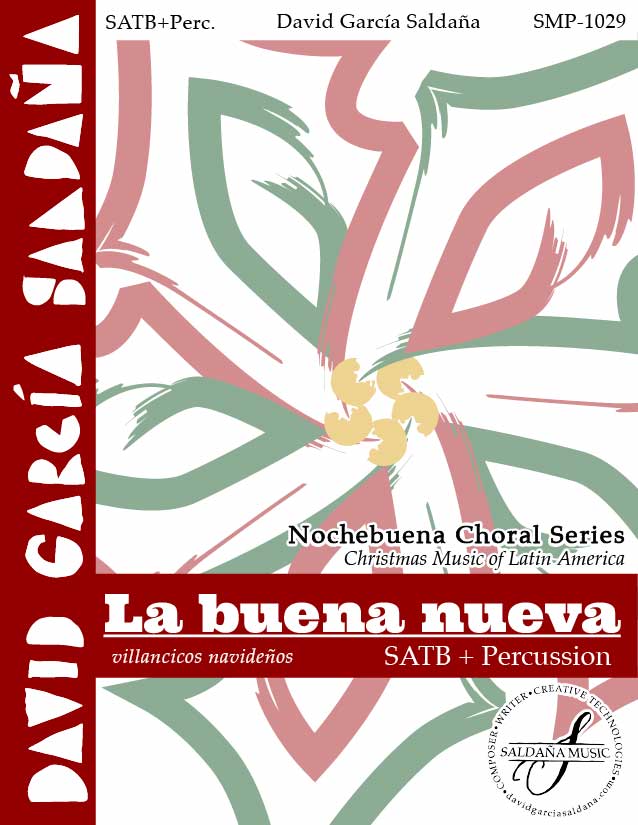 Notes:
Notes:
“La buena nueva” (translates to “The Good News”) comes to international attention because of a famous 1965 recording of villancicos, “Ronda de Navidad,” sung by a Peruvian Catholic school’s children’s choir, the Coral Infantil Colegio “Manuel Pardo de Chiclayo.” This tune is often misattributed in textbooks and hymnals as a traditional Peruvian villancico, but is most likely written by contemporary Criollo singer-songwriter Mario Cavagnaro Llerena (1926-1998), unpublished, and often mistitled “Rueda, rueda por la montaña” or “Huayno navideño.” Some early recordings also title this tune “Navidad en el Perú.”
This arrangement embeds a huayno rhythm, an indigenous Peruvian rhythm, in the vocal polyphony. This rhythm, played on indigenous large drums, is abbreviated in the score for frame drum (low). A rain stick addition pays homage to the Andean origin of the instrument as well.
Pronunciation Guide:
*Universal/Neutral Spanish pronunciation should be attempted in performance.
AUDIO FILE COMING SOON
Lyrics:
Rueda, rueda, por la montaña, blanca lunidad,
Llega, llega, cholo, cholita, es la navidad.
Vuela, vuela, blanca paloma, sigue más allá
Lleva, lleva, la buena nueva, es la navidad.
Lleva lejos la buena nueva, es navidad,
Que esta noche, a medianoche Jesús nacerá.
Translation:
Round the white lit mountain,
It comes, cholo, cholita*, it is Christmas.
Fly, fly, white dove, far away.
Spread the good news, it is Christmas.
Spread the good news far, it is Christmas.
That this night, at midnight, Jesus will be be born.
Perusal & Purchase
Lindo niño (Ecuador)
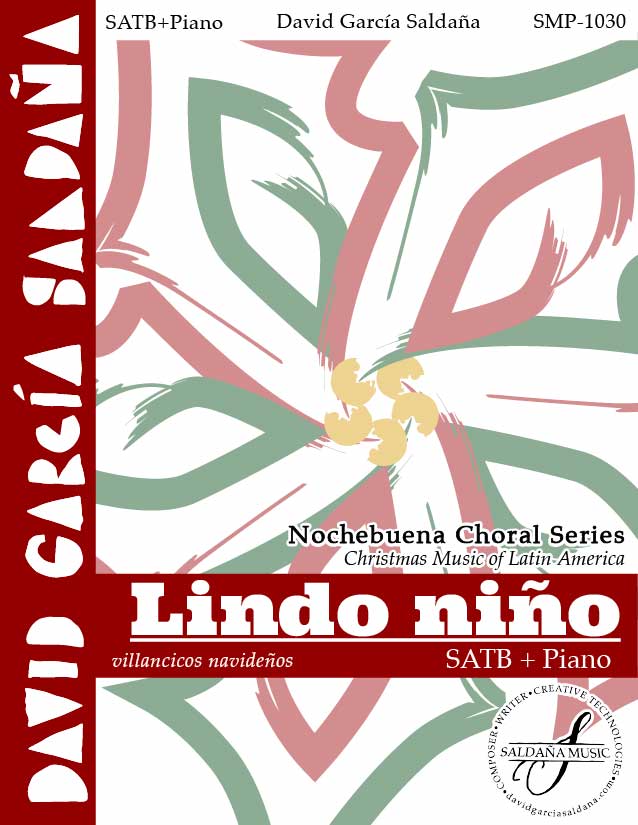 Notes:
Notes:
Los Pibes Trujillo recorded their “Villancicos Navideños” album in 1970, bringing popular Ecuadorian villancicos to international acclaim. “Lindo niño,” among Salvador Bustamante Celi’s (1876-1935) popular villancicos, had a bright waltz feel on the album, contrasting the tragic story of child abuse underpinning the recording process. Similarly tragic, Celi, in 1910, had to escape Lima due to war with Perú at the border, and traveled to Guayaquil. Although economic and political instability tends to correlate with weakened historical and cultural documentation, Ecuador and some of it’s neighboring countries have maintained a unique Catholic novena (nine day religious celebration) from December 16-24 named the “Novena del Niño” or “Novena de Aguinaldos” that includes daily villancico singing and prayer.
Upon listening to Pamela Cortés’s recorded version, the joyous hope from anticipating the arrival of the child feels poignant against the melancholic musical background. This arrangement builds on Cortés, with the primary melody often falling out of alignment with the instrumentation, forming hemiolas, before the rhythmic motive returns to alignment.
Pronunciation Guide:
*Universal/Neutral Spanish pronunciation should be attempted in performance.
AUDIO FILE COMING SOON
Lyrics:
Lindo niño tus ojuelos son dos astros de los cielos.
Lindo niño tus bracitos son la red de puro y amor.
Lindo niño tu boquita, más graciosa que la rosa,
y tus labios encendidos, más purpúreos que el clavel.
Lindo niño me arrebatas, lindo niño yo te adoro.
Lindo niño mi tesoro para siempre tú serás.
Mil pintadas avecillas, te alaban sin cesar,
con sus dulces melodías y sus cantos sin igual.
De María virgen pura, ha nacido el buen Jesus.
¡Gloria a Dios en las alturas y a la gente paz y bien!
*Adorar al niño, corramos pastores.
*Adorar al niño, llevamoslé flores.
Translation:
Beautiful child, your eyes are two stars in the heavens.
Beautiful child, your arms embrace with purity and love.
Beautiful child, your little mouth is more graceful than the rose,
and your burning lips, more purple than the carnation.
Beautiful child, you captivate me. Beautiful child, I adore you.
Beautiful child, you will always be my treasure.
A thousand vibrant birds praise you, untiring,
with sweet melodies and special songs.
From the virgin Mary, Jesus is born.
Glory to God in the highest, and to all: peace and goodwill!
*To adore the child, we must run, shephards.
*To adore the child, we bring flowers.
Perusal & Purchase
Los tres Santos Reyes (Puerto Rico)
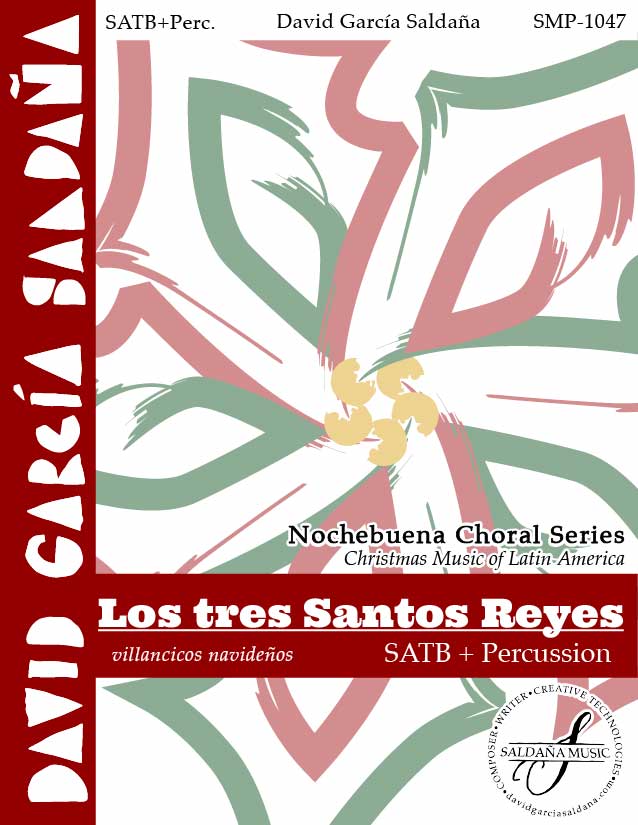 Notes:
Notes:
Many cultures of Latin America celebrate the novena following Christmas Day, leading to the Epiphany and the arrival of the three Wise Men, or Holy Kings (Reyes Magos), to Jerusalem. In Puerto Rico, children receive gifts from the three Reyes Magos as most American children are told Santa delivers. Epiphany rivals the importance of Christmas Day. This aguinaldo, “Los tres Santos Reyes,” originally a parranda (similar to caroling) in an upbeat plena style, provides a festive backdrop to the end of the Christmastime season, complete with the mystery of following a star to distant locales, led by faith that their actions would be in service of a better world.
The arrangement may be sung a cappella, or with a minimum of a guiro and conga, with a demonstration rhythm abbreviated below the vocal parts. The plena is a simple, but structured form, with the accompaniment focused on providing a stable backdrop to improvised sung lines and lyrics. The masters of plena are able to strew together large form narratives with intricate melismatic melodies.
Pronunciation Guide:
*Universal/Neutral Spanish pronunciation should be attempted in performance.
AUDIO FILE COMING SOON
Lyrics:
Los tres Santos Reyes, los tres y los tres,
Los saludaremos con divina fe.
Los tres santos Reyes, yo los sé contar,
Melchor y Gaspar y el Rey Baltazar.
Llegan con cautela, la Estrella los guía
se sienten sus pasos en la noche fría.
¡Señores, adiós! Doy la despedida
al corazón santo, dulce de María
Señores adiós porque ya nos vamos.
¡Todos los presentes pasen feliz año!
Translation:
The three Holy Kings, we three,
Will greet you with divine faith.
The three holy Kings, I know how to count them,
Melchor, Gaspar, and King Baltazar.
They arrive cautiously, the star guides them.
You can feel their footsteps in the cold night.
Goodbye, all! I say goodbye
to the holy, sweet heart of Mary.
Goodbye all, because we are leaving,
And a happy New Year to everyone!
Vamos, pastores, vamos (Colombia)
Notes:
“Vamos, pastores, vamos” has an elusive origin story, with the popular “Flor y Canto” hymnal crediting Evaristo Ciria Sanz, a Spanish Catholic priest and musician, while more sources claim authorship by Jeremías Quintero Gutiérrez, a prolific Colombian songwriter claimed to have written over 3,000 villancicos. Quintero is credited with other popular villancicos thematically centered around pastores including “Venid Pastorcillos” and “Pastorcillos de Naplusa”. This tune, though, has permeated throughout the American continents, becoming a ubiquitous villancico.
The text retells the announcement to the shepherds of Jesus’s birth, and captures the excitement and journey that the shepherds took to go to Bethlehem. This arrangement composes a new musical section that sonifies the jingle jangle of the rush to Bethlehem, using polyphony to capture the various voices of anticipation and joy (gusto) of the journey to see the newborn baby. The text is a recombination of the original verses in order to present a more secular telling of the story.
Pronunciation Guide:
*Universal/Neutral Spanish pronunciation should be attempted in performance.
AUDIO FILE COMING SOON
Lyrics:
Vamos pastores, vamos
Vamos a Belén
A ver en ese niño
La gloria del Edén
La gloria del Edén
¡Ese precioso niño!
Que nunca podrá ser
Que su belleza copie
El lápiz y el pincel.
El padre le acaricia
La madre mira en Él
Y los dos extasiados
Contemplan aquel ser
Contemplan aquel ser
Un establo es una cuna,
su casa es un portal
y sobre duras pajas
por nuestro amor está.
Allí duerme el niñito
junto a un mulo y un buey,
y bien cobijadito,
con María y José.
Con María y José.
Translation:
Now let us go, O shepherds
Let’s go to Bethlehem
To see in that child,
The glory of Eden!
The glory of Eden!
What a precious baby!
It’s impossible
to capture his beauty
by pencil nor by brush.
The father caresses him,
The mother looks at him,
And the two are ecstatic.
They contemplate that baby.
They contemplate that baby.
A stable as a cradle,
A hallway as a house,
and he lays on hard straw
All for his love for humanity.
There the little boy sleeps
next to a mule and an ox,
and warmly covered by a blanket
with Mary and Joseph.
With Mary and Joseph.
